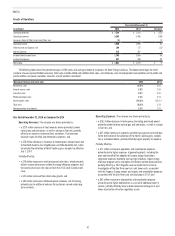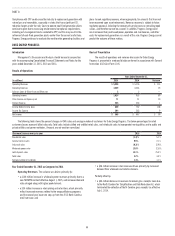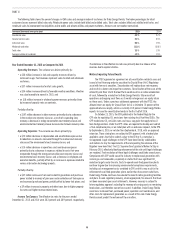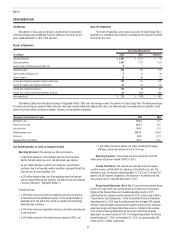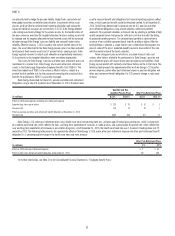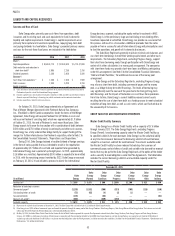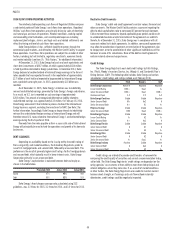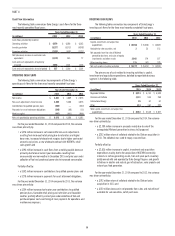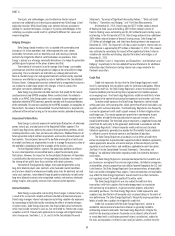Duke Energy 2015 Annual Report Download - page 71
Download and view the complete annual report
Please find page 71 of the 2015 Duke Energy annual report below. You can navigate through the pages in the report by either clicking on the pages listed below, or by using the keyword search tool below to find specific information within the annual report.
51
PART II
The majority of Duke Energy’s business is in environments that are either
fully or partially rate-regulated. In such environments, revenue requirements
are adjusted periodically by regulators based on factors including levels of
costs, sales volumes and costs of capital. Accordingly, Duke Energy’s regulated
utilities operate to some degree with a buffer from the direct effects, positive
or negative, of significant swings in market or economic conditions. However,
significant changes in discount rates over a prolonged period may have a
material impact on the fair value of equity.
As of August 31, 2015, all of the reporting units’ estimated fair value of
equity substantially exceeded the carrying value of equity.
For further information, see Note 11 to the Consolidated Financial
Statements, “Goodwill and Intangible Assets.”
Long-Lived Asset Impairment Assessments, Excluding Regulated Operations
Property, plant and equipment, excluding plant held for sale, is stated
at the lower of carrying value (historical cost less accumulated depreciation
and previously recorded impairments) or fair value, if impaired. Duke Energy
evaluates property, plant and equipment for impairment when events or changes
in circumstances (such as a significant change in cash flow projections, the
determination that it is more likely than not an asset or asset group will be
sold) indicate the carrying value of such assets may not be recoverable. The
determination of whether an impairment has occurred is based on an estimate
of undiscounted future cash flows attributable to the assets, as compared with
their carrying value.
Performing an impairment evaluation involves a significant degree of
estimation and judgment in areas such as identifying circumstances that
indicate an impairment may exist, identifying and grouping affected assets, and
developing the undiscounted future cash flows. If an impairment has occurred,
the amount of the impairment recognized is determined by estimating the fair
value and recording a loss if the carrying value is greater than the fair value.
Additionally, determining fair value requires probability weighting future cash
flows to reflect expectations about possible variations in their amounts or
timing and the selection of an appropriate discount rate. Although cash flow
estimates are based on relevant information available at the time the estimates
are made, estimates of future cash flows are, by nature, highly uncertain and
may vary significantly from actual results. For assets identified as held for
sale, the carrying value is compared to the estimated fair value less cost to sell
to determine if an impairment loss is required. Until the assets are disposed
of, their estimated fair value is re-evaluated when circumstances or events
change.
When determining whether an asset or asset group has been impaired,
management groups assets at the lowest level that has discrete cash flows.
For further information, see Note 2 to the Consolidated Financial
Statements, “Acquisition and Dispositions.”
Accounting for Loss Contingencies
Preparation of financial statements and related disclosures require
judgments regarding the future outcome of contingent events. Duke Energy is
involved in certain legal and environmental matters arising in the normal course
of business. Estimating probable losses requires analysis of multiple forecasts
and scenarios that often depend on judgments about potential actions by third
parties, such as federal, state and local courts and regulators. Contingent
liabilities are often resolved over long periods of time. Amounts recorded in the
consolidated financial statements may differ from the actual outcome once the
contingency is resolved, which could have a material impact on future results of
operations, financial position and cash flows of Duke Energy.
For further information, see Notes 4 and 5 to the Consolidated Financial
Statements, “Regulatory Matters” and “Commitments and Contingencies.”
Revenue Recognition
Revenues on sales of electricity and gas are recognized when either the
service is provided or the product is delivered. Operating revenues include
unbilled electric and gas revenues earned when service has been delivered
but not billed by the end of the accounting period. Unbilled retail revenues
are estimated by applying an average revenue per kilowatt-hour (kWh) or per
thousand cubic feet (Mcf) for all customer classes to the number of estimated
kWh or Mcf delivered but not billed. Unbilled wholesale energy revenues are
calculated by applying the contractual rate per MWh to the number of estimated
MWh delivered but not yet billed. Unbilled wholesale demand revenues are
calculated by applying the contractual rate per MW to the MW volume delivered
but not yet billed. The amount of unbilled revenues can vary significantly from
period to period as a result of numerous factors, including seasonality, weather,
customer usage patterns, customer mix, timing of rendering customer bills, and
the average price in effect for customer classes.
Pension and Other Post-Retirement Benefits
The calculation of pension expense, other post-retirement benefit expense
and net pension and other post-retirement assets or liabilities require the use
of assumptions and election of permissible accounting alternatives. Changes
in assumptions can result in different expense and reported asset or liability
amounts, and future actual experience can differ from the assumptions. Duke
Energy believes the most critical assumptions for pension and other post-
retirement benefits are the expected long-term rate of return on plan assets and
the assumed discount rate applied to future benefit payments. Additionally, the
health care cost trend rate assumption is critical to Duke Energy’s estimate of
other post-retirement benefits.
Duke Energy elects to amortize net actuarial gains or losses in excess
of the corridor of 10 percent of the greater of the market-related value of plan
assets or plan projected benefit obligation, into net pension or other post-
retirement benefit expense over the average remaining service period of active
covered employees. Prior service cost or credit, which represents the effect
on plan liabilities due to plan amendments, is amortized over the average
remaining service period of active covered employees.
Duke Energy maintains non-contributory defined benefit retirement
plans. The plans cover most U.S. employees using a cash balance formula.
Under a cash balance formula, a plan participant accumulates a retirement
benefit consisting of pay credits based upon a percentage of current eligible
earnings based on age and years of service and current interest credits. Certain
employees are covered under plans that use a final average earnings formula.
As of January 1, 2014, the qualified and non-qualified non-contributory defined
benefit plans are closed to new and rehired non-union, and certain unionized
employees.
Duke Energy provides some health care and life insurance benefits
for retired employees on a contributory and non-contributory basis. Certain
employees are eligible for these benefits if they have met age and service
requirements at retirement, as defined in the plans.
As of December 31, 2015, Duke Energy assumes pension and other post-
retirement plan assets will generate a long-term rate of return of 6.50 percent.
The expected long-term rate of return was developed using a weighted average
calculation of expected returns based primarily on future expected returns across
asset classes considering the use of active asset managers, where applicable.
Equity securities are held for their higher expected returns. Debt securities


